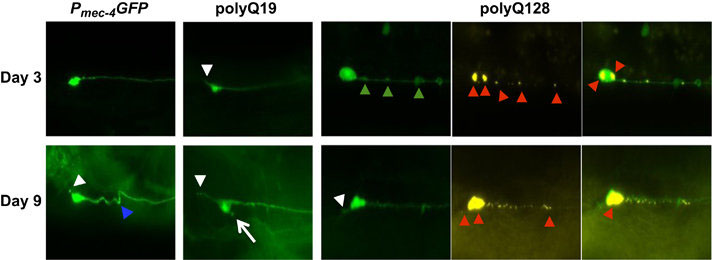加齢中のC. elegansニューロンの形態リモデリングはタンパク質恒常性の乱れによって変化する
Morphological remodeling of C. elegans neurons during aging is modified by compromised protein homeostasis
2016年4月7日 npj Aging 2, Article number:16001 (2016) doi:10.1038/npjamd.2016.1
神経科学:ニューロンの加齢と関係するタンパク質の維持管理

タンパク質の折りたたみと維持管理の異常は、ニューロンの形状に加齢関連の変化を生じる場合がある。アラスカ大学フェアバンクス校(米国)のElena Vayndorfと米国、カナダ、およびフランスの共同研究者らは、加齢関連の神経変性疾患であるハンチントン病をヒトに生じさせる遺伝子の一部分を特定のニューロンが発現する系統の線虫Caenorhabditis elegansを調べた。また、正常なニューロンでタンパク質の産生、折りたたみ、輸送、および分解に関与する遺伝子の発現を遮断した。その2つの実験操作により、加齢の過程で通常生じる線虫ニューロンの形態に変化が観察された。C. elegansとヒトではニューロンが似ていることから、研究チームは、タンパク質の維持管理を誘導する細胞経路を標的とする薬物がハンチントン病のような加齢関連の神経疾患の脳機能維持に有用なのではないかと論じている。
Neuroscience: Protein maintenance linked to neuronal aging
Misfolded proteins and disrupted protein maintenance can lead to aging-related changes in neuron shape. Elena Vayndorf from the University of Alaska Fairbanks and colleagues in the US, Canada and France studied a strain of nematode Caenorhabditis elegans in which selected neurons express part of the human gene responsible for Huntington’s disease, which is an aging-related, neurodegenerative disorder. The researchers also blocked expression of genes involved in protein manufacture, folding, trafficking and degradation in healthy neurons. With both experimental manipulations, they observed changes in the morphology of the animal’s neurons that normally occur during aging. Given the similarities between C. elegansand human

